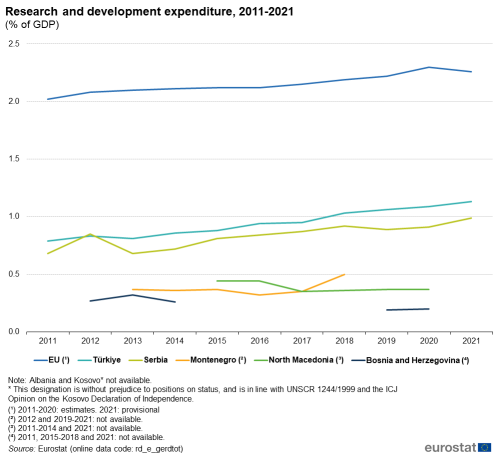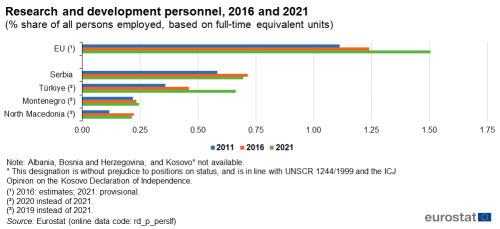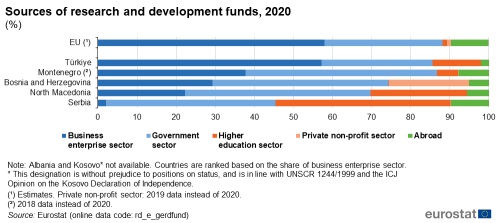Enlargement countries - statistics on research and development
Data extracted in May 2023.
Planned article update: May 2024.
Highlights
R & D staff as a percentage of total employment in 2021 was 0.70 % in Serbia, 0.66 % in Türkiye, 0.24 % in Montenegro and 0.22 % in North Macedonia.
In 2021, among the Western Balkans for which data are available, and Türkiye, R & D expenditure as a percentage of GDP was highest in Türkiye, with 1.1 %, followed by Serbia with 1.0 %, while in the EU it was 2.3 %.
The business enterprise sector accounted for 57 % of the R & D expenditure in Türkiye in 2021. This sector provided between 2 % and 38 % of all funds for R & D in the Western Balkans for which data are available.
This article is part of an online publication and provides information on a range of R & D statistics for the Western Balkans and Türkiye and compares this with the corresponding data for the European Union (EU). Within this region, Bosnia and Herzegovina, Montenegro, North Macedonia, Albania, Serbia and Türkiye are candidate countries, while Kosovo* has the status of potential candidate.
Data for Georgia, Moldova and Ukraine, granted candidate status or European perspective by the European Council in June 2022, are not included in this article; Statistics Explained articles on the European Neighbourhood Policy-East countries are available here.
This article gives an overview relating to R & D in the Western Balkans and Türkiye, presenting indicators such as the level of gross domestic expenditure on R & D (GERD), the ratio of R & D expenditure to gross domestic product (GDP) (also known as R & D intensity), R & D expenditure by source of funds, and the number of R & D personnel and researchers.
* This designation is without prejudice to positions on status, and is in line with UNSCR 1244/1999 and the ICJ Opinion on the Kosovo Declaration of Independence.
Full article
Research and development expenditure
Research and Development expenditure as a percentage of GDP provides a measure of ‘R & D intensity’ that can be compared over time and between economies. Countries that have higher economic output per person will normally have a higher degree of ‘R & D intensity’ than the ones with lower economic output.
In 2021, R & D expenditure in Türkiye accounted for 1.1 % of the country’s GDP, an increase from 0.8 % a decade earlier; Turkish R & D intensity was higher than that of the Western Balkans for which data are shown in Figure 1. The next highest level in 2021 was 1.0 % of GDP in Serbia, where the ratio had been 0.7 % in 2011. In Montenegro, R & D expenditure grew from 2011, when it accounted for 0.3 % of GDP, to 0.5 % in 2018 (latest available data). In North Macedonia, R & D expenditure has remained around 0.4 % of GDP during the period for which data are available, 2015-2020. R & D expenditure in Bosnia and Herzegovina has declined as a percentage of GDP, from 0.3 % in 2012, the earliest year for which comparable data are available, to 0.2 % in 2020.
For comparison, R & D intensity in the EU in 2021 was 2.3 % of GDP, 0.3 percentage points higher than in 2011.

(% of GDP)
Source: Eurostat (rd_e_gerdtot)
Gross domestic expenditure on R & D (otherwise referred to as GERD) includes expenditure on R & D performed by business enterprises, higher education institutions, as well as government and private non-profit organisations. R & D expenditure by source of funds describes the origin of R & D funding. Due to a lack of data for 2021, 2020 is being used as the reference year.
Analysing the source of funds for research and development, illustrated in Figure 2, in Türkiye, the business enterprise sector was the largest source of funding for R & D, providing 57.2 % of funds in 2020. Government accounted for 28.4 % of funds and the higher education sector 12.3 %. Funds from abroad accounted for 2.0 % of the total.
In contrast, in Montenegro in 2018 (latest data available), government provided 49.0 % of funds; the business sector 37.8 %; funds from abroad 7.8 %; and higher education 5.4 % of the total. In North Macedonia, the government accounted for 47.4 % of funds in 2020; business 22.3 %; higher education 24.7 % and foreign sources 5.6 %. In Serbia, the higher education sector was the main source of funding in 2020, with 44.7 % of the total. The government sector, followed closely with 43.4 % of R & D expenditure and funding from abroad with 9.6 %, the highest in these countries. Business accounted for 2.1 % of the total, the lowest in these countries. The funding of research and development in Bosnia and Herzegovina was derived from government with 45.0 %; business 29.4 %; non-profit 20.5 %; and external funding 5.1 % of the total in 2020. In comparison, the non-profit sector ranged between 0.0 and 0.2 % in the other countries from the region for which data are available.
Analysis of R & D expenditure by source of funds in the EU in 2020 shows that 57.9 % of total expenditure was funded by business enterprises, while 30.2 % was funded by government, and a further 9.6 % came from foreign funds. Higher education accounted for 1.2 %, while non-profit sector accounted for the remaining 1.1 % in 2019 (latest data available).
Research and development personnel and researchers
R & D personnel consist of all individuals employed directly in the field of R & D, including persons providing direct services, such as managers, administrators and clerical staff. Research and development personnel as a percentage share of all persons employed, measured on a full-time equivalent basis, is used to make comparisons over time and between countries. The data are illustrated in Figure 3.
Among the four countries for which recent data are available, Serbia had the highest share of R & D personnel in total employment in 2011, 2016 and 2021, increasing over the period from 0.58 % to 0.70 % but declining somewhat between 2016 and 2021. Next highest in 2020 (latest data available) was Türkiye with 0.66 %, an increase from 0.46 % in 2016 and 0.36 % in 2011. Montenegro reported an R & D share of employment at 0.24 % in 2019 (latest available data), a bit higher than in 2016 (0.23 %) and 2011 (0.22 %). In North Macedonia in 2021, 0.22 % of persons employed worked in research and development, an increase from the 0.12 % recorded in 2011 but a stagnation compared to 2016.
R & D personnel accounted for 1.50 % of total employment in the EU in 2021, up from 1.24 % five years earlier and 1.11 % ten years earlier.

(% share of all persons employed; based on full-time equivalent units)
Source: Eurostat (rd_p_perslf)
Source data for tables and graphs
Data sources
In a number of areas, candidate countries (and sometimes also potential candidates) are in a position to provide harmonised data in accordance with the EU acquis with respect to methodology, classifications and procedures for data collection and the principles of official statistics as laid down in the European statistics Code of Practice. In these cases, the candidate countries (and potential candidates) concerned report their data to Eurostat following the same procedures and under the same quality criteria as the EU Member States and the EFTA countries. Data from the enlargement countries that meet these quality requirements are made available free-of-charge on Eurostat’s website, along with data for EU Member States and EFTA countries.
The definitions of basic concepts, data collection guidelines, and classifications for compiling research and development (R & D) statistics are available in Frascati Manual. Eurostat data on R & D aim to show a comprehensive picture of the situation in the EU, covering indicators related to expenditure and personnel. Most of the main indicators within this domain are available at a national and a regional level for the EU Member States.
Context
R & D is the main driver of innovation, with the level of R & D expenditure and the ratio of R & D intensity being two of the key indicators used to monitor resources devoted to science and technology.
The European Research Area (ERA) aims to create a single, borderless market for research, innovation and technology across the EU. The free circulation of researchers and knowledge enables:
- better cross-border cooperation
- building of critical mass
- continent-wide competition
This initiative was revitalised in 2018. Its current targets are to:
- strengthen mobility of researchers and the flow of knowledge
- incentivise investing in research and innovation
- promote gender equality and diversity in science
- enhance cooperation among universities, business and other research and innovation actors
Information concerning the current statistical legislation on R & D can be found here.
While basic principles and institutional frameworks for producing statistics are already in place, the Western Balkans and Türkiye are expected to increase progressively the volume and quality of their data and to transmit these data to Eurostat in the context of the EU enlargement process. EU standards in the field of statistics require the existence of a statistical infrastructure based on principles such as professional independence, impartiality, relevance, confidentiality of individual data and easy access to official statistics; they cover methodology, classifications and standards for production.
Eurostat has the responsibility to ensure that statistical production of the enlargement countries complies with the EU acquis in the field of statistics. To do so, Eurostat supports the national statistical offices and other producers of official statistics through a range of initiatives, such as pilot surveys, training courses, traineeships, study visits, workshops and seminars, and participation in meetings within the European Statistical System (ESS). The ultimate goal is the provision of harmonised, high-quality data that conforms to European and international standards.
Additional information on statistical cooperation with the Western Balkans and Türkiye is provided here.
Direct access to
- Enlargement countries — statistical overview — online publication
- Statistical cooperation — online publication
- All articles on science and technology
- R&D expenditure
- R&D personnel
- Science and technology
- Statistical books/pocketbooks
- Key figures on enlargement countries — 2019 edition
- Key figures on enlargement countries — 2017 edition
- Key figures on the enlargement countries — 2014 edition
- Factsheets
- Basic figures on the candidate countries and potential candidates — Factsheets — 2023 edition
- Basic figures on Western Balkans and Türkiye — Factsheets — 2022 edition
- Basic figures on enlargement countries — Factsheets — 2021 edition
- Leaflets
- Basic figures on enlargement countries — 2020 edition
- Basic figures on enlargement countries — 2019 edition
- Basic figures on enlargement countries — 2018 edition
- Basic figures on enlargement countries — 2016 edition
- Enlargement countries — Demographic statistics — 2015 edition
- Key figures on the enlargement countries — Population and social conditions — 2013 edition
- Research and development (research)
- Statistics on research and development (rd)
- R&D expenditure at national and regional level (rd_e)
- R&D personnel at national and regional level (rd_p)
- Statistics on research and development (rd)
- Statistics on research and development (rd) (ESMS metadata file — rd_esms)
